Pam Withers's Blog, page 15
March 8, 2015
The story behind writing Daredevil Club
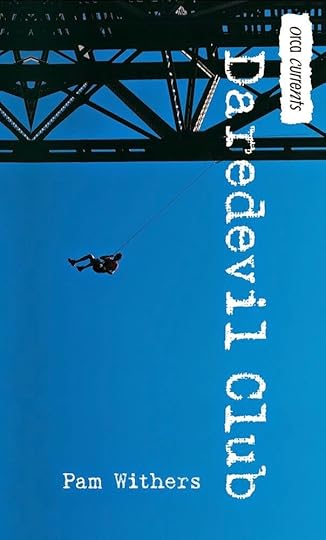
The fear of getting caught was part of the excitement.Kip’s only friends are the members of the Daredevil Club, whose mission is to complete seven dangerous dares before their rivals, the Wildmen, complete their list of dares. Kip had been the leader of the Daredevil Club before he lost the use of his leg in an accident. Now he has difficulty completing the dares. But Kip refuses to back down and admit that he may not be up for the stunts.
When I injured my back in a (non sports-related) fall many years ago, I went from being super-active and athletic to not being able to walk, sit or stand for very long at all. At times, I used a cane, and required wheelchair transport in airports. I endured chronic pain for years.I wrote many of my books during that time with voice-activated software, because I could not sit at the computer much. But the hardest adjustment of all was losing touch with many friends because what we’d always had in common was sports. I could no longer do sports. And I spent a lot of time with physiotherapists and chiropractors. (Happily, I’ve recovered to a large extent.) Clearly, the plot of Daredevil Club (in which Kip is willing to take unreasonable risks even after being injured, to keep up with friends) grew directly from that period.
“Kip,” [says the physio], “let’s see if your workouts have increased your range of movement this week. I’m hoping for big things today.”That meant big pain, I knew. But I knew I could handle it. I was an athlete. I was competitive. Just because I wasn’t in sports anymore didn’t mean I lacked an opponent. My adversary was the part of me that still didn’t work.
How did I come up with the seven dares that Kip’s gang attempts to do? I asked all the dads on my block the dumbest things they did as teens that they would never tell their teenage kids about. I ended up with a list of twenty-seven stupid “dare” types of things they did! We had a good laugh building that list. Other trivia regarding Daredevil Club:
It is set in a fictional “hick” town called Peever. I grew up near Peever, South Dakota. (I was going to donate a copy of Daredevil Club to Peever Library when I finished, but it turns out they don’t have a public library.) One of the dares involved crawling through a metal culvert. When dropping my son off at snowboarding one day, I saw a pile of metal culverts in the ski hill parking lot waiting for use in a construction project. When no one was looking, I crawled through one to make sure I’d be able to describe it realistically. To describe the bridge girders along which they crawled, I did a long walk and pause under Burrard Street bridge in Vancouver, Canada (where I live). The dunk tank in the fair was fun to describe. My husband once built one for my son’s backyard birthday party when my son was a preteen. On page 51, Kip is in the physio’s waiting room when he picks up a motorcycle magazine and sees a two-page photo spread of a guy on a dirt bike doing a backflip thirty feet above two piles of dirt. Kip wonders whether the stunt worked out or whether maybe the guy landed on his back and was now in a wheelchair. I was writing Dirtbike Daredevils (my book on dirt biking) around the same time as I wrote Daredevil Club; that's where that idea came from. http://www.amazon.com/Dirtbike-Daredevils-Take-Xtreme-Withers/dp/1552858049/ref=sr_1_1?s=books&ie=UTF8&qid=1425840256&sr=1-1&keywords=dirtbike+daredevils When I speak at schools, I’ve noticed that the boys especially lovehearing me talk about Daredevil Club. And they always want to know what else the dads on my block came up with that I didn’t include. As if I’d reveal that! Hey, maybe there’s another book in the rest of that list.
To order Daredevil Club: http://www.amazon.com/Daredevil-Club-Orca-Currents-Withers/dp/1551436140
Published on March 08, 2015 12:00
March 6, 2015
Book club maestro (or secrets of making a book club work, esp. for boys)
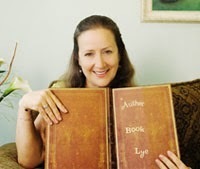
by Pam Withers, www.pamwithers.com
Few people have put as much time and effort into figuring outwhat makes a book club successful as Christianne Hayward, whohas been running them for sixteen years. As a single mother of two boys (one a keener reader than the other), she decided to apply her Ph.D. in education toward inspiring a love of reading in children of all ages. She started her first parent-and-youth book club at thelocal community center as a way to ensure that her sons had aliterary group to socialize with. This book club was so well receivedthat she added a new book club each year, culminating in seventeenparent-and-youth book clubs ranging from preschool to gradetwelve. Today, her Lyceum of Literature and Art in Vancouver,Canada (http://www.christiannehayward.com/), provides a unique, cozy, and specialized learning environment that brings forth the best of afterschool reading and writing experiences for hundreds of children per week. Her book clubs area family affair where parents read the books, attend the groups,and participate in the discussion along with their children.Hayward serves as a consultant to educators and book clubleaders around North America. What she finds most gratifying,however, is running into families of her grown students who say,“You made such a difference. Even though my child attended yourclub for only a year, he became a reader for life.”
Q: What are some of the key ways you engage the boys inyour clubs, as opposed to the girls?A: First, you need a lot of humor. Boys respond well to a bit oflighthearted ribbing. Second, I serve food and hot chocolate, hotapple cider, or herbal teas; humans gather more willingly if foodis involved. (At home, we all settle in with a comfort drink in acomfortable space to read.) Third, I put up lots of books withmale protagonists and subjects to which boys can relate easily.A democratic voting system for selecting the books to be read,buys a certain ownership and involvement from all participants.Fourth, I use kinesthetic ways of learning: crosswords that testwhether they’ve taken in details of the book we’ve just read, artprojects connected to the book’s scenes, and breaks that featurefood mentioned in the book. Finally, I let them move around. In aphoto of a kindergarten story-time at the Lyceum, you can see thegirls sitting straight and staring at the book, and the boys loungingon the pillows. But if you look closely, you can also see how incrediblyengaged those boys are.As for the older boys, I tell them that the best way to understandthat strange group of people called “girls” is to read some bookswith a female protagonist. It’s amazing how they internalize that.Once I ran into a boy in second-year university who’d been in oneof my book clubs years before. “You were so right about that!” heenthused.
Q: Some of the boys in your clubs come with their mothers,and some with their fathers. How important is the genderrole-model factor?A: For the boys to see a male involved in a book club is huge, but itdoesn’t have to be their father. We often get uncles, older brothers,and grandfathers and everyone benefits from their presence. Boyswho come with their mothers forge better communication withthem than boys who don’t; book clubs allow the mothers to talkto their sons about difficult topics through a literary character.Dads who attend our clubs raise the bar for everyone, becausethey tend to be avid notetakers and they hate not doing well onthe crosswords.Most importantly, the youth see men reading and discussingreading, or what I call “socializing around reading.” Women dothis more naturally, while men tend to socialize around sports orgames instead. Since coaches don’t usually read books betweenperiods, and guys don’t typically discuss books after a game, youhave to find a way to expose them to this modeling, by making aneffort at home or enrolling them in a book club.
Q: Roughly what percentage of boys are reluctantreaders?A: In my experience, it can be as high as forty percent. The dividebegins in about fourth grade, and has to do with under-acknowledgedbrain differences, a lack of books that interest boys (especiallyafter sixth grade if they’re not into fantasy), not seeing mensocialize around reading, and a more auditory-driven educationsystem. Boys often respond better to kinesthetic and visuallearning: Pictionary, graphic books, charades, dramatizations,debates, crosswords, exercise balls for sitting, and art. At-homereading and book clubs can cater to these needs more easily thantraditional classrooms. The optimal point at which you can makea big difference is in grades four, five, and six, by choosing booksthat are fun and engaging, by pumping up the number of graphicbooks you let him read, and by modeling and sharing your passionfor reading at home.
Q: Some parents steer their kids away from picture booksand graphic novels before the child wishes to give them up,on the assumption that these are unsophisticated forms ofreading holding him back. What’s your advice?A: Don’t get too stuck on this. Our youth have to be more visuallyliterate than we were, able to deconstruct symbols in imagesand make meaning. Even PowerPoint presentations at CEO meetingstoday have more animation, logos, and visual symbols. Whenparents read a graphic novel, it seems choppy to them, but today’schildren know how to bridge between cells in much the same wayyou do between lines of a poem. Graphic books engage a differenttype of literacy. This doesn’t replace textual literacy but is just asimportant.If you keep throwing books at your boy that are too difficult,you’ll lose him. One of my sons didn’t read for enjoyment until ageten; it was a graphic novel that finally hooked him. He’d alwaysbeen able to decode competently, and had been read to, but readingfor enjoyment took longer to kick in. Get them graphic books,auditory tapes, interactive books online, whatever it takes. Keepthem in the game until their maturity catches up with them.
Q: What’s your best advice to parents who want their childto be a keen reader?A: Let him be involved in choosing what he reads, and continuereading to him even after he can read by himself. Where you applyyour greatest influence in what your son reads is through thebooks you read to him. Start reading to him long before seventhor eighth grade; otherwise he might be less open to reading aloudexperiences. Choose themes that interest him, books that have thehook within the first chapter. Read several chapters ahead yourselfbefore sitting down with him, so you won’t stumble over namesand if you start to lose his attention, you can synthesize what’shappening and take him forward to an exciting bit, closing on acliffhanger if at all possible. This way, he’ll plead and beg you toread more, but don’t give in. Make him come to the book hungrythe next day. Also, read to your kids when you’re fresh. For me asa single mother, being fresh meant early in the morning instead ofat bedtime, and always in the same space with our comfort drinksin hand.There are three kinds of reading: independent reading (he readsby himself, preferably books he has chosen; no more than one errorper page), guided reading (he reads a page, you read a page; nomore than four errors per page), and reading aloud (you do all thereading). There’s typically a two-year reading-level gap betweenexpressive and receptive language development, meaning thereis a dramatic spread between what he can read on his own andwhat he can understand orally. By reading aloud, you’re buildingthe scaffolding that will make him a stronger reader, helping himunderstand patterns, reinforcing his ability to predict plotlines,helping him understand causal relationships, and exposing him tothe cadence of oral language.
Q: Why is it important to learn to enjoy reading?A: Reading is an investment in yourself, an education in itself. Itnurtures curiosity and a thirst for learning more; it can be veryaddictive once you have a good experience with it. Literacy isincredibly important for accessing information, engaging personalgrowth, and nurturing breadth of knowledge. It supports emotionalintelligence, which you need in order to excel at the top levelsof industry. Emotional intelligence helps you relate to someonedifferent than you at work. It helps you articulate your thoughts,which can boost your ability to speak in front of a group. Broadreading exposes you to other perspectives, which is very preciousin a diverse society.Excerpted from Jump-Starting Boys: Help Your Reluctant Learner Find Success in School and Life, by Pam Withers and Cynthia Gill (Viva Editions). Formerly posted on keenreaders.org.http://www.amazon.com/Jump-Starting-Boys-Reluctant-Learner-Success-ebook/dp/B00BAHA0Y8/ref=sr_1_1?s=books&ie=UTF8&qid=1421455869&sr=1-1&keywords=jump+starting+boys
Published on March 06, 2015 12:04
March 4, 2015
Latest book, first review!
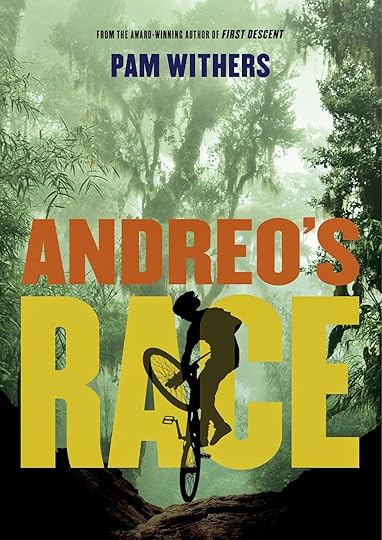
From the School Library Journal, my first official review on Andreo's Race, which is out April 14, 2015 (but can be pre-ordered now; see link at bottom of this blog)
http://bookverdict.com/details.xqy?uri=Product2015-03-01-1088854.xml
This action-packed book revolves around the topics of adventure races and illegal adoptions, managing to make both interesting and highly readable.Sixteen-year-old Andreo was adopted as a baby, and his family’s upcoming team adventure race in Bolivia is a chance for him to learn more about his origins. When his friend and fellow adoptee Raul discovers that they may have been stolen as babies from their rightful parents, the pair resolve to investigate during the race.Andreo navigates through nighttime cycling, awkward family dynamics, and wanted criminals in his search for his birth mother. The experience of adventure racing is brought to life in the story, with readers experiencing the intensity of training and competition through Andreo. The excitement of the sport is mirrored by his emotional hunt for clues leading to his birth family, and his discoveries and achievements are well paced. Andreo’s imperfect relationship with his adoptive family is the most strained part of the story but works as a plot device, and is resolved in the all’s-well ending. The simple, straightforward language, surprise twist, and nonstop action will appeal to reluctant readers looking for a thrilling novel.–Marian McLeod, Convent of the Sacred Heart, Greenwich, CT
Withers, Pam. Andreo’s Race. 224p. ebook available. Tundra. Apr. 2015. pap. $12.99. ISBN 9781770497665.
to order Andreo's Race: http://www.amazon.com/Andreos-Race-Pam-Withers/dp/1770497668/ref=sr_1_1?s=books&ie=UTF8&qid=1425515354&sr=1-1&keywords=andreo%27s+race
Published on March 04, 2015 16:35
February 27, 2015
The story behind writing Breathless
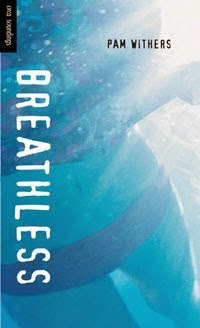
Underwater, a girl’s view of how to catch a guy can get distorted.
And the thing about panicking when you’re forty feet under the ocean’s surface is that you can drown, and you know you can drown. In fact, you can’t breathe without your regulator even if you’re not panicking. You’re also not supposed to hold your breath, because there’s pressure underwater. That means if you’re not breathing out bubbles while the regulator is out, your chest might expand until it explodes.
Although girls read all my adventure books (thank goodness!), Breathless is the only novel I’ve written that could be called a girl book. As in, it has a female protagonist and issues that interest teen girls (catching a guy, losing weight, handling a situation where a guy hits on her to the point where it could almost be called date-rape).I wrote Breathless the same year I was in the middle of my Xtreme series, or more specifically the same year I wrote Surf Zone, which has diving scenes in it as well.I took up diving specifically to help me write both books. I was forty feet under on my tenth dive when I had a full-on panic attack. The instructor saw what was happening, swam up to me, put his face mask against mine to hold eye contact and took me slowly to the surface. (Too fast and you can blow out your eardrums.)You’ll find that scene recreated in Breathless– except then the protagonist gets a crush on her divemaster and things develop from there.In my case, I found the courage to submerge again and complete my diving exam, to receive my certification. Then I asked my instructor if he’d help me with the diving scenes in Breathless and Surf Zone, which he did. After reading over the scenes, he complained, “But they do everything wrong!”“Of course they do,” I responded. “How else would it be exciting?”To know what they could do wrong and right, however, I felt a need to take up diving as well as work with an expert.Meanwhile, my diving instructor ended up with two free autographed books. I autographed them, “From your worst diving student.” He told me I was not his worst diving student, which I find really scary!In the plot, fifteen-year-old Beverly has two goals: to lose ten pounds in ten days (way too fast to be safe) and to “catch a guy.” The guy she catches is eighteen, and has an agenda beyond hers.When I was fifteen, I was quite heavy, and always going on ill-advised crash diets. So the way that Bev sneaks around avoiding or hiding food is all based on stuff I did. I slimmed down after university by eating nothing but salads and toast for a few months, and by taking up kayaking and running and weight training. I’ve never been heavy since, which is why I’ve been questioned suspiciously by high school girls who’ve read Breathless, as to how I could create a character like Bev. But hey, I’ve been Bev. And the trouble she gets into with her crash diet hopefully offers lessons to readers.Why have I never (yet) written another book specifically targeting girls? First of all, my former literary agent told me, “Don’t even think about it. You have built a niche writing for boys.”I didn’t have to listen to her, but you know what? Something like eighty-five per cent of authors who write for teens and children are female, and they’re far more likely to write series like The Baby-Sitters Club than boy-friendly books about sports. And I’ve become quite passionate about getting more boys to read, and so I’ve stuck with my niche. On the other hand, all my adventure books have strong, go-for-it girls in them, even if the main protagonist is a boy. So I definitely have a female audience as well, and I take pride in that.
By the way, Breathless has also been translated into Spanish and Serbian! I read the entire book in Spanish. It took me longer to do that than it took to write it in the first place. But it was an accomplishment. :)
In Spanish:
http://www.amazon.com/Respira-Spanish-Soundings-Pam-Withers-ebook/dp/B00CRQ9GY6/ref=sr_1_2?s=books&ie=UTF8&qid=1425066743&sr=1-2&keywords=breathless+pam+withers In English:
http://www.amazon.com/Breathless-Orca-Soundings-Pam-Withers-ebook/dp/B0055FE3O4/ref=sr_1_1?s=books&ie=UTF8&qid=1425066665&sr=1-1&keywords=breathless+pam+withers
Published on February 27, 2015 11:56
February 24, 2015
Check out my new website!
Published on February 24, 2015 12:55
February 20, 2015
Seven ways to help turn your son around

Yes, today’s kids are heavily influenced by school, peers, and the media, but parents can and should reassert control to ensure they prosper in work and in life. Here are some tips for concerned parents.1) This generation’s college degree is the equivalent of last generation’s high school degree. So talk with your son about how the world has changed since you were young—how decent grades are much more important, and how studies show that the more he reads, the better grades he’ll get. If a male relative or friend conducts the chat with him, even better for the role-model factor.2) Determine your son’s learning style and adapt homework support sessions and teaching moments to it.3) Limit children’s total media time to no more than one to two hours of quality programming per day, as recommended by the American Academy of Pediatrics. 4) Engage in short family debates on a regular basis to sharpen his confidence with reasoning and words, and comment on his delivery more than content.5) Shift from a focus on building his self-esteem, independence, and individualism to one of modeling and promoting perseverance, humility, and community service. Jean M. Twenge, associate professor of psychology and author of Generation Me, writes that self-esteem without basis encourages laziness rather than hard work, and the ability to persevere and keep going is a much better predictor of life outcomes than self-esteem. Her book, The Narcissism Epidemic, includes a self-test for determining one’s degree of egocentrism, and suggestions for lessening it.6) Guard against overprotecting and over-scheduling your son, since many characteristics that lead to achievement are best nurtured by independent free time. Further, resist engaging in a sense of competition with other parents, which encourages him to compare himself with fellow classmates, often leading to lowered empathy and a lifetime habit of stress, frustration, and over-scheduling.7) Expand your tolerance for toilet humor and fighting scenes in books he selects, and don’t pressure him to abandon picture books or graphic novels (a classy version of comic books) before he chooses to. Literacy experts say these books can develop a child’s critical thinking skills in particular ways, and the vocabulary is often more challenging than in a chapter book.
Excerpted from Jump-Starting Boys: Help Your Reluctant Learner Find Success in School and Life, by Pam Withers and Cynthia Gill (Viva Editions). All references (footnotes) contained in the book.
http://www.amazon.com/Jump-Starting-Boys-Reluctant-Learner-Success-ebook/dp/B00BAHA0Y8/ref=sr_1_1?s=books&ie=UTF8&qid=1424464538&sr=1-1&keywords=jump-starting
Published on February 20, 2015 12:31
February 17, 2015
The story behind writing Camp Wild
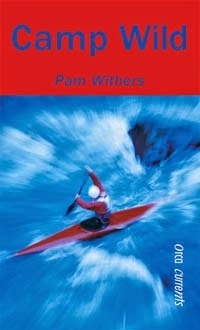
One in a series of stories-behind-writing-the-books, which I offer intermittently here on my blog.
At fifteen Wilf is certain that he is too old for summer camp. When his parents ignore his protests and ship him off anyway, he decides to escape from camp by canoe and spend the rest of his vacation alone in the woods, proving to his parents he deserves his independence. His plan begins to unravel when his cabin mate forces Wilf to take him along and a younger camper follows them. They all end up in a fight for their lives against the unforgiving river.
This is my most humorous book by far, and try as I might since, I've never managed to concoct another character as bitingly sarcastic and full of zingy one-liners as Wilf. That makes this one of my favorite books, and reading from it always goes over well during school visits.I also think the two main characters’ issues – Wilf’s parents are workaholics and Herb’s are over-hovering sorts – are real.Herb is also an annoying geek:
His round face and innocent expression make him a candidate for a Boy Scouts poster. He holds his slightly lumpy body as awkwardly as a heron emerging from an oil slick. Adventurous this guy is definitely not, I decide.
Herb: "I've never camped before, so I kind of need someone to show me the ropes."Wilf: Ropes, eh? I picture myself handing him a rope shaped like a noose.
Of course, running a summer camp for six years for teens learning whitewater kayaking gave me plenty of material to work with. And since whitewater paddling has been a long-time passion of mine, the plot line was fun and easy to build. I also spent more than a few summers at camps in my youth, sometimes canoeing under the instruction of my camp-manager parents. And yes, stealing food is always one of campers’ favorite sports.
After canoeing and kayaking class comes lunch, where my main project is spiriting away as many cans of food as will fit up my sleeves, down my shorts or under my baseball cap. The trick is getting stuff out without a soul seeing me. This, as it turns out, is where I truly excel. Although I don't expect to be around for Camp Wild's last-day awards ceremony, I reckon I'd ace the blue ribbon for food-supplies diversion if I were.
Getting kitchen patrol is like winning the lottery at Camp Wild. Even though it means scrubbing pots for an hour, it also means potential access to the pantry’s box of chocolate bars. Never mind that Cook makes you whistle the whole time you are in the pantry. (That way you can't stuff anything in your mouth.) She also checks your pockets when you come out. But the best-informed campers know she does not check socks or hats.
When my husband was a kid, his mother made him whistle whenever he entered the pantry to get something for her. J
Then there’s the junior counsellor Claire, who adds to the fun in the book:
Claire is on shore fitting out the munchkins in puffy orange lifejackets. I admire her pierced navel from afar, not for the first time.
Claire gives me a glowing smile that makes me think I'm going to capsize in my canoe right then and there and need a deep-water rescue if not mouth-to-mouth resuscitation.
Herb was named after my long-time kayaking pal Herb Whitehead. I presented the book to him while he was in the hospital; he passed away some time later. I will forever miss his high energy, sense of fun and heart of gold. The book is dedicated to my childhood nanny, Lucille Dougherty, who read it shortly before she turned 100. When she finished it, she turned to me and said, "This doesn't sound like you at all!" Assuming she meant Wilf’s sarcasm and considerable attitude, I took it as a compliment.Camp Wild was the first of three (so far) adventure novels I’ve written for Orca Books http://www.orcabook.com/client/client_pages/landingpage.htmlwhich specializes in novels for reluctant readers, also known as hi-lo or quick reads books. I have always admired Orca’s dedication to this line, which surely keeps many youths from falling off the reading wagon, or tempts them back on. Orca even has hi-lo books for adults now.
Camp Wild on Amazon:http://www.amazon.com/Camp-Wild-Orca-Currents-Withers-ebook/dp/B00580VCP4/ref=sr_1_1?s=books&ie=UTF8&qid=1424138560&sr=1-1&keywords=camp+wild
Published on February 17, 2015 11:39
February 14, 2015
The story behind writing First Descent
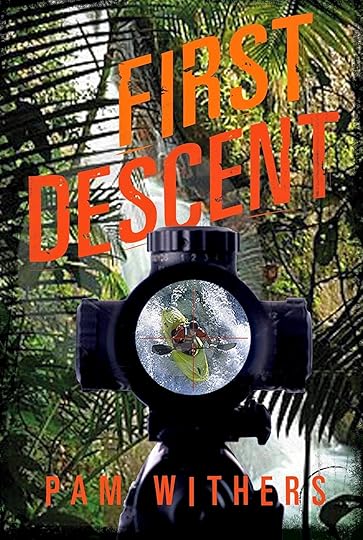
One in a series of stories-behind-writing-the-books, which I offer intermittently here on my blog.
Montana-born Rex loves nothing more than to take his kayak out on a river, the faster and more powerful the better. When he gets the opportunity to tackle the well-named El Furioso in southwest Colombia, he is thrilled. He anticipates the river’s challenges, but finds himself in a situation where the real danger is human.In Colombia, he meets Myriam Calambás, an indígena, who has lived along the El Furioso all her life. Though she loves its rushing waters, she dreams of leaving to get an education so that she can help her people. Her dreams, and her very survival, are in the balance when she and Rex are caught up in the clash between paramilitaries, working for rich landowners, and guerillas, who are supposed to be protecting the poor.Pam Withers’ skill at writing about extreme adventures combines with a compelling story about an endangered world and a people struggling for their very right to exist.
Interviewed by Darian Tichler
So Pam, you've been a whitewater kayak instructor and written several books on the sport. How did you first get into it?
My parents taught canoeing, and I enjoyed that. Then, my very first semester of university, as a cub reporter for the university newspaper, I found myself covering a kayak race. The minute I’d finished interviewing the instructor, I asked to join the class. It looked to me like the cool version of canoeing. I had no idea it was a wet, cold, scary and dangerous sport, but by the time I’d figured that out, it was too late, because I was hooked.
Have you ever had to make any dangerous calls on the water?
Having been involved in the sport for more than 25 years, I’ve had to make numerous calls I’d rather not think about – but I guess I made the right decisions often enough to still be around to write this book.
Extreme danger, racism, warring factions, death and destruction! This book doesn't hesitate to delve into the farthest reaches of the human experience, and yet the romance that some authors capitalize on (hem hem, Twilight) is somewhat played down. As exciting as Rex and Myriam’s relationship is, it doesn’t have the same emotional highs as the whitewater rapid scenes. How and why did you plan the relationship between Rex and Miriam to go the way it does?
From the earliest notions of this story, I wanted a slightly arrogant whitewater kayaker and a indigenous person who had her own troubles to deal with. In other words, two highly different cultures, clashing. I figured that would provide plenty of tension for the novel. By adding a hint of romance, I ratcheted up the tension.
So it was a natural extension of the original characters you conceived of?
Exactly.
 Pam rafting in Ecuador while researching First DescentDid you base your characters consciously or unconsciously on people you know?
Pam rafting in Ecuador while researching First DescentDid you base your characters consciously or unconsciously on people you know?As a female in a male-dominated sport, I have dealt with more than my share of slightly arrogant male paddlers. So Rex was easy to develop as a character. He's not based on any one person – if he were, I couldn't admit it or I might get sued! Miriam took a lot more research to develop, and I consulted extensively with a young Colombian anthropologist, Lina, who had worked in the region where my novel is set. I explained the novel’s plot to Lina, and then spent hours interviewing her so she could help me develop Myriam’s character. It was Lina who named Myriam.
So Lina kind of created Myriam?
Definitely. I hoped that would help make Myriam authentic.
Rex has some negative characteristics that, should we meet him in real life, might even cause us to dislike him – racism, cockiness, pride. Yet we remain curious about him because of the danger he is constantly in, and because we want to know if he conquers his river. Were you ever tempted to have something horrible happen to him or to make him completely the anti-hero?
He was definitely the anti-hero throughout my early drafts -- too much so. It's dangerous for an author to make a hero an anti-hero. The hero has to be sympathetic even if he has some unlikable qualities. The first few versions of the manuscript, Rex was way too unlikable. I had numerous early readers tell me so. In fact, at one writers’ retreat, the instructor told me, "You obviously hate Rex, so why don't you just make Miriam the protagonist?" Some book reviewers have said that Myriam became just that, sort of stole the show, but I really wanted to keep Rex the main person. So in my rewrites, I really worked at toning Rex down, making him likable and sympathetic even while a touch arrogant.
Did you want Rex rather than Myriam to be the main character because you thought your readership might sympathize more with a white male than with an indigenous female?
Perhaps, but more-so because I have a reputation of writing for boys, with boy heroes. Also, I felt I knew Rex intimately, from having lived so long in the paddling world. Myriam took longer to get into.
What's the deal with the avocado sandwich?

In the story, Rex’s grandfather traded an avocado sandwich for a valuable necklace owned by an indigenous woman, who agreed to the unfair trade only because she was starving. One editor who looked at an early version of my manuscript told me that story was completely unrealistic and I should delete it. The irony is that that plot element grew from an actual event, and was one of the first seeds from which the whole idea of the book grew. I have a friend, who must remain unnamed, who in her 20s was backpacking in a remote part of South America when she came across an indigenous man who tried to sell her a cultural treasure. She told him she had no money and showed him her avocado sandwich to prove that that was all she had on her. He told her he would accept the avocado sandwich as payment for this item. Astonished, she went ahead and made the trade, even though it was illegal for her to take that item out of the country. She feels badly about that trade to this day, yet has the item displayed on her bedroom bookshelf. When she showed it to me and told me the story, it got my creative juices going.
It seems like a lot of research went into this novel. How did the experience of writing it rate next to your other novels?
Most of my other novels took me two to four months to write. This one took me a year. Also, because I had a writing grant, I was able to pay for a researcher, article translator and interviewee: Lina, the Colombian anthropologist. She subsequently became a friend and my Spanish tutor. My husband made me promise I wouldn’t go to Colombia – many parts of it are still dangerous – so I went to Ecuador instead. During my time there I rode a zipline – there’s a zipline in First Descent – and rafted down a whitewater river. I also went to a refugee centre with a translator and got permission to interview Colombian refugees.
Did you become interested in the plight of indigenous people before or after you started this book?
As some of my readers will know, I have had First Nations characters in some of my previous novels as well – Raging River, Peak Survival and Surf Zone. I spent most of my growing up years around native reserves because my father, a minister, served reservation churches most of his life. My 17-year-old niece, Esther, who is half native-American, served as one of my teen readers. She was upset by the chapter in which Rex snubs an attractive First-Nations girl in his high school, solely on the basis that his grandfather would not approve. “Why?” she asked me, and I couldn’t find any words to explain why some people are like that.
So this is your 15th book, and you have another on the way. Any plans for slowing down, or are there are still stories to be told?
I’ll never run out of ideas, but I am slowing down in how fast I put out books. A few years ago, it was two to three a year.
How would you describe the experience of writing your first novel — in five words or less.
Gung-ho enthusiasm plus total naivety.
Do you have any tips for up-and-coming writers?
Hold on to that enthusiasm as long as you can. Follow your passion. But support it with courses/books/CDs/DVDs on the writing craft, like those from Writers Digest Books. The best book I've found is The Writer's Journey by Christopher Vogler. The best CD/DVD I’ve found is The Hero’s Two Journeys by Michael Hauge and Chris Vogler.
Buy First Descent through Amazon:
http://www.amazon.com/First-Descent-Pam-Withers-ebook/dp/B004J4X316/ref=sr_1_1?s=books&ie=UTF8&qid=1423948112&sr=1-1&keywords=first+descent
Published on February 14, 2015 14:31
February 13, 2015
Juggling projects
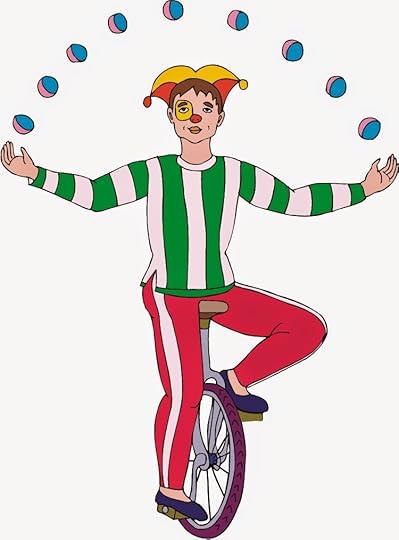
Help! I am working at three novels at one time. I hate that. I only like to work on one at a time. (Though I know one author who always likes to work on two at a time. She calls one her “morning novel” and the other her “afternoon novel,” and says she gets more work done per day by switching to a different project than if she stuck with just one.)I just finished and submitted one a few weeks ago, and had started on another when I realized that I had an outline in a drawer that I meant to pull out and turn into a novel after the one I just finished. So I am busy converting the outline, but the other new one won’t stop percolating in my mind, so that one is still on a burner, developing slo-mo.Then I was given some changes to make to the one I just turned in, so… arrgh! Three on my plate. Morning, afternoon and night?
Published on February 13, 2015 14:50
February 8, 2015
Pros and cons of hot housing our children
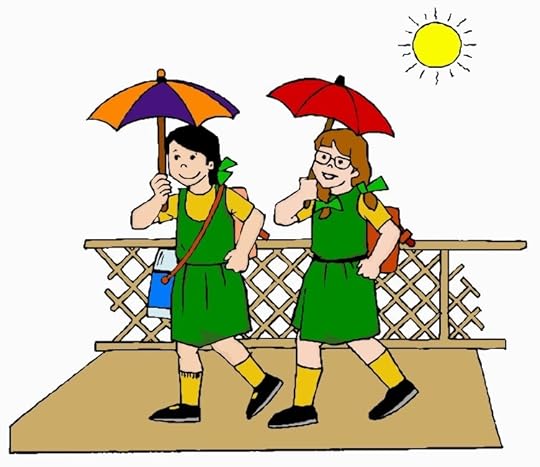
In our competitive world, parents concerned about their children’s future job prospects are naturally inclined to provide them with as many advantages as possible: private kindergarten places, tutoring, sports coaching and more.Does it work? To some extent, but not as much as we like to think, and not necessarily to society’s long-term benefit, according to a recent article in The Economist (Jan. 24-30, 2015, “An hereditary meritocracy.”)The best predictor of American children’s success in school is their parents’ educational level – and increasingly, the money those parents spend on supporting their child. Parents may or may not be aware that they’re sucked into this expensive competition largely because “funding levels per pupil can vary by up to 50% across a state.” Add to that the fact that even universities able to offer lots of financial aid remain focused on accepting students who can pay their full way (especially children of alumni), and you have a system that is fast drifting away from the concept that success can be clinched by any hardworking person.Florida senator Marco Rubio says these factors are “eroding” the United States.As for parents hot housing their offspring, an Organisation for Economic Co-operation and Development study shows that “early years investment” does not automatically usher young people to success. The research shows that a good start is not enough on its own; a strong system with consistency “matters just as much and possibly more.”Another report (Alliance for Higher Education and Democracy, Feb. 3, 2015 release) indicates that between 1970 and 2013, the percentage of students from low income families earning bachelor degrees increased 6-9%, while the percentage of those from wealthy families increased 44-77%. Perhaps for every dollar we spend on tutoring our children, we should donate a certain amount towards scholarships for the less fortunate? Or for every hour we spend endeavoring to get our children ahead, we donate time or money to organizations like Big Brothers or to local reading buddy programs?
Published on February 08, 2015 18:56





